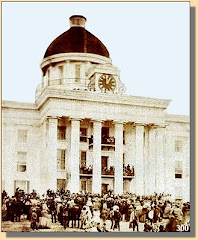
As you may have noticed, I placed George Bingham's painting, Stump Speaking(1853-54), in the upper left hand corner of this blog. I did this to remind me that this blog is as important in distributing information concerning town and county politics as it is in distributing national political information. Although there is some "stumping" that occurs today, it must have been very intriguing to sit and listen to two political opponents practice their oratorical skills, or lack thereof, in front of a vast audience.
How do politicians get their constituents votes today? When I vote, I have to show valid identification, be checked off on a registration sheet, sign a book, receive my ballot, mark my ballot, and finally, place it in the monstrosity of a ballot counting machine. This was not the case in the Antebellum Period. For example, Bingham's painting, The County Election (1851-52), shows several voting actions we would consider illegal or oddities today.
John Weinberg, writes that "balloting, which in those days was not secret, proceeds on the courthouse porch. The process was particularly open to corruption, since it was easy to eavesdrop and thereby intimidate voters or verify if bribes had been effective. A man in red swears on the Bible that he has not previously voted in the election, an action which might establish the solemnity of the occasion if not for the general raucousness of the assembled crowd. Drunkenness is suggested by the broadly smiling man in the foreground who holds his glass up to be filled with hard cider--a favorite tool for attracting voters to a candidate's side. Liquor seems to have completely overwhelmed another man, who is literally dragged to the polls to cast a ballot. This figure, with bowed head and limp limbs, recalls images of Christ being taken down from the cross. But here religious connotations are erased, and the suggestion of death may be an allusion to the practice of getting votes from the rolls of the dead. Another indication of illegality is the battered fellow sitting on a bench to the right, a wooden plank at his feet. His sorry condition may suggest physical coercion or a political argument that has taken a violent turn. The power of both money and chance is symbolized by the toss of a coin directly below the swearing-in. As if to further undermine the gravity of the occasion, two small boys play mumble-the-peg in the foreground."




2 comments:
Reminds me of Jill Lepore's lecture this fall at UNCG on the rise of the paper ballot.
For more information on Bingham's painting check out Patrick Lewis' post on the Army of Tennessee blog at www.bullyforbragg.blogspot.com
Post a Comment